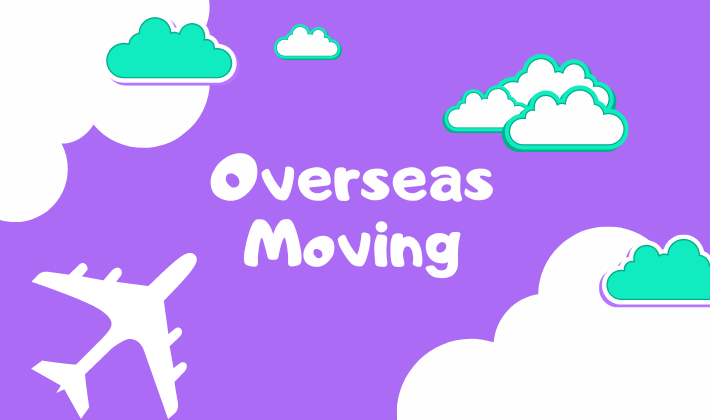After deciding on my husband’s assignment to India, I attended a briefing for overseas assignees conducted by his company. During the session, they also explained about the relocation process. The company instructed us to:
- Ship our household goods via sea freight or air freight.
- Transport and store the remaining household items within Japan to a trunk room or a designated location, such as our parents’ house.
These were the options provided, all to be arranged through the same transportation company. We were given a list and told to choose an moving company from it.

Ugh, do I really have to decide on this? It’s such a hassle.
But it’s my first time sending stuff abroad, and it’s super important.
Okay, time to buckle down and do this!
With a heavy heart, I began researching overseas moving companies. Today, I’ll share the points I considered when selecting a moving company and the tips I received from the chosen company to make the overseas move successful.
Choosing an Overseas Moving Company: Comparison Methods
When it comes to domestic moves in Japan, we often request quotes from companies like Sakai Moving Center, Art Moving Center, Nittsu, Hikkoshi no Mark, Yamato Home Convenience, Heart Moving Center, and Ark Moving Center. With reviews available online, it’s relatively easy to make comparisons.
However, international moves entail numerous complex procedures and preparations. Moreover, word-of-mouth reviews for overseas moves are scarce. Therefore, it’s crucial to choose a reputable moving company. I focused on the following five points:
Quality and International Standards (FIDI/IAM)
Have you heard of FIDI?
While researching overseas moving companies, I came across FIDI (Federation Internationale des Demenageurs Internationaux), a global organization comprising over 500 reputable international movers from more than 100 countries across five continents. Companies that meet FIDI’s stringent evaluation criteria (covering facilities, quality management, risk management, staff suitability, and over 250 other factors) can obtain FAIM (FIDI Accredited International Movers) certification, which ensures adherence to international quality standards for overseas moves.
In addition to FAIM, there’s the International Association of Movers (IAM), the world’s largest international moving industry association, with over 2,000 member companies in over 170 countries.
While it’s understandable within Japan, managing quality down to the local level overseas is no small feat. Meeting such rigorous international standards requires significant corporate effort. If a company clears these tough overseas criteria, it should provide peace of mind.
With that in mind, we decided to go with a moving company that has been objectively recognized for its excellent quality.
IAM’s website allows you to search for companies with various credentials. Like this.


Source: IAM
Track Record
The number of years in service is also an essential indicator. Companies that have been in business for many years have accumulated extensive experience and are better equipped to handle any issues that may arise.
When searching for moving companies on the IAM website, you can confirm the “Years in service” on the left side of the search results. (You can also confirm this in the image above, I believe.)
In the case of representative companies as of May 2024, the years of experience are typically displayed as follows:
- Fukuoka Soko: Years in service: 76
- Japan Move Co., Ltd.: Years in service: 19
- Yamatane Corporation: Years in service: 100
- Yamato Transport Co., Ltd.: Years in service: 19
- Yokohama System Mover Co. Ltd.: Years in service: 48
Area Coverage
It’s also important to consider whether there are branches or affiliated partners at your destination. Companies with strong local support will promptly handle any post-move issues.
Different moving companies have varying expertise and language capabilities in different countries. By choosing a company knowledgeable about the laws and regulations of your destination country, you can expect a smoother transition.
The list of overseas moving companies provided by my husband’s company specifies the countries each company specializes in. Of course, we’ll choose a company strong in India.
Range of Services
The scope of services provided is also crucial:
- Transportation by sea and air, including the duration of transportation (how many months it will take)
- Provision of storage facilities within Japan
- Transportation of household goods to family homes, etc.
- Warehouse storage prior to overseas shipment (duration)
- Contents of overseas marine cargo insurance
- Packing services
- Japanese language support on-site
- On-site estimation visits
For our household, the first three were specified by the company, so naturally, companies capable of handling those were listed. However, I also checked what other aspects they would take care of. It’s reassuring when they can handle more.
Personally, packing services and on-site Japanese language support were essential. I couldn’t imagine how much cushioning material to use when sending items overseas, and I didn’t have the confidence to handle everything in English if trouble arose in India.
Compatibility with Assigned Staff
I believe the experience and responsiveness of assigned staff are crucial in selecting a moving company. After all, our trust in the company’s personnel directly impacts the contract.
The speed of email and phone responses, the content of meetings (expertise, etc.), and overall professionalism were assessed to determine if we could entrust our belongings to them.
Result Announcement
Taking into account the above factors, we chose “Yamatane” for our move. Here’s why:
- Member of IAM and FIDI
- Established for over 100 years
- Network and partners in India
- Packing services and local Japanese support available
- The sales representative was extremely kind
Now, we can only hope for a smooth shipment and delivery of our belongings.
Process from Estimate to Completion of Move
Here are the steps and key points for a successful overseas move, as advised by Yamatane:
- Estimate: Choose between an online meeting or an in-person assessment.
- Meeting: Create an ideal shipping schedule based on factors such as the volume of belongings and travel timing.
- Document Preparation: Prepare necessary documents and classify belongings (sea freight/air freight).
- Moving Process: The company handles the packing, transportation, and unpacking of belongings.
- Local Procedures: Complete customs clearance and other local procedures.
Other than steps 3 and 4, which we need to handle ourselves, Yamatane will take care of the rest.
Tips for a Successful Move
Be Sure to Schedule a Site Visit
I highly recommend arranging for a physical site visit rather than relying on photos or online meetings. Contrary to popular belief, it doesn’t take much time, and the benefits are invaluable.
By physically inspecting your belongings, the company can provide a more precise estimate of the volume and weight of your shipment, right on the spot. Also, they can identify items you may have forgotten or overlooked.
Here are some insights we gained from our interaction with the representative:
- “Do you have golf clubs? (I have forgotten about them at my parents’ house.)”
- “Many people choose to bring trouser presses with them. (I was thinking of disposing of it.)”
- “You can take Muji clothing cases as they are. (No need to repack them.)”
Their prompt and insightful comments during the visit were extremely enlightening.
Create a Schedule
During the site visit or even before that, let’s have them create a model and ideal schedule.
As this was our first overseas move, we weren’t quite sure about our schedule preferences.



I’m not sure when would be the best time for them to come and pick up our belongings.
So, we simply asked, “Could you please suggest an ideal schedule?”
Thorough Document Preparation
It seems that any discrepancies or missing documents for the customs clearance process during an overseas move can significantly delay the receipt of your belongings.
Since my husband will be relocating first, we had a detailed list prepared for what he needs for his relocation and what the rest of the family will need when we join him in India.
Furthermore, we made sure to request documents not only in hard copy but also in digital format via email.
Properly Classify Belongings
During our conversation, we were told, “We’ll take care of the packing on the moving day, so you don’t need to worry about that. But the most important thing is sorting out your belongings.”
Since the arrival times differ for air and sea shipments, they advised us to classify our belongings based on three factors:
1. Frequency of use
2. Time of use
3. Weight
(Sea Shipment) Low←Frequency→High (Air Shipment)
(Sea Shipment) Later←Time→Immediate (Air Shipment)
(Sea Shipment) Heavy←Weight→Light (Air Shipment)
Conclusion
In conclusion, moving overseas is a significant event!
To ensure the safe transportation of our and our family’s precious belongings, careful selection of a moving company is essential. Today, I recorded how our family chose a moving company and the points to remember for a successful move.
To everyone preparing for an overseas assignment, may your move be successful!!! (And ours too…!!!)









